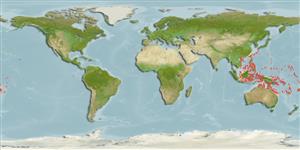>
Eupercaria/misc (Various families in series Eupercaria) >
Scaridae (Parrotfishes) > Scarinae
Etymology: Scarus: Greek, skaros = a fish described by anciente writers as a parrot fish; 1601 (Ref. 45335).
More on author: Bleeker.
Environment: milieu / climate zone / depth range / distribution range
Ekologi
laut; payau berasosiasi dengan karang; kisaran kedalaman 1 - 25 m (Ref. 90102). Tropical; 30°N - 24°S, 107°E - 170°W
Western Pacific: Indonesia to Samoa, north to the Ryukyu Islands, south to the Great Barrier Reef. Replaced by Scarus scaber in the Indian Ocean (Ref. 37816).
Size / Weight / umur
Maturity: Lm ? range ? - ? cm
Max length : 40.0 cm TL jantan/; (Ref. 48636)
deskripsi pendek
Kunci identifiaksi (pengenalan) | Morfologi | Morfometrik
Duri punggung (Keseluruhan (total)) : 9; duri punggung lunak (Keseluruhan (total)) : 10; Duri dubur: 3; Sirip dubur lunak: 9. Males recognized by the blue snout and band behind eye. Eastern form has blue cheek and western form has yellow cheek. Females grey to yellow with dusky saddle over back (Ref. 48636). Closely resembles S. oviceps and S. scaber. In S. oviceps, the initial phase has fewer, less vertical diagonal dark bars on the back and the terminal phase lacks the light-centered bar between the eye and the pectoral fin base, is darker and less brilliant blue on the upper head and back, and is usually larger.
Inhabits coral-rich areas of clear, protected reefs (Ref. 9710). Found in lagoon and seaward reefs (Ref. 90102). Feeds mainly on algae (Ref. 26993).
Life cycle and mating behavior
Kematangan | Reproduksi, perkembang biakan | Pemijahan | telur-telur | Fecundity | Larva
Oviparous, distinct pairing during breeding (Ref. 205).
Parenti, P. and J.E. Randall, 2000. An annotated checklist of the species of the labroid fish families Labridae and Scaridae. Ichthyol. Bull. J.L.B. Smith Inst. Ichthyol. (68):1-97. (Ref. 35918)
Status IUCN Red List (Ref. 130435: Version 2024-2)
ancaman kepada manusia
Harmless
penggunaan manusia
Perikanan: komersial; Akuarium: Komersial
Alat, peralatan
laporan khas
muat turun XML
Sumber internet
Estimates based on models
Preferred temperature (Ref.
123201): 25.2 - 29.3, mean 28.5 °C (based on 1649 cells).
Phylogenetic diversity index (Ref.
82804): PD
50 = 0.5000 [Uniqueness, from 0.5 = low to 2.0 = high].
Bayesian length-weight: a=0.01380 (0.00789 - 0.02416), b=3.13 (2.98 - 3.28), in cm total length, based on LWR estimates for this species & Genus-body shape (Ref.
93245).
Trophic level (Ref.
69278): 2.0 ±0.00 se; based on food items.
Daya lenting (Ref.
120179): sedang, Waktu penggandaan populasi minimum 1.4 - 4.4 tahun (Preliminary K or Fecundity.).
Fishing Vulnerability (Ref.
59153): Low to moderate vulnerability (30 of 100).
Nutrients (Ref.
124155): Calcium = 45.6 [23.8, 73.3] mg/100g; Iron = 0.696 [0.433, 1.175] mg/100g; Protein = 18.3 [16.3, 20.2] %; Omega3 = 0.06 [0.04, 0.10] g/100g; Selenium = 19.9 [9.9, 35.8] μg/100g; VitaminA = 44.9 [12.2, 162.7] μg/100g; Zinc = 2.69 [1.84, 3.65] mg/100g (wet weight);
